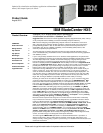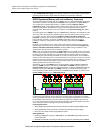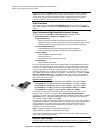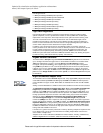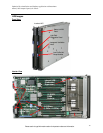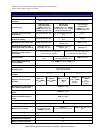
Optimized for virtualization and database applications with maximum
memory and compute capacity in a blade
Please see the Legal Information section for important notices and information.
2.
IBM’s eX5 technology-based systems are the ideal solution for scale-up database-serving
applications on Microsoft
®
Windows
®
with Microsoft SQL Server
®
or IBM DB2
®
, as well as Linux
®
with Oracle or DB2. Database hosting demands ultimate server reliability features, and once
installed, they tend to grow and grow, requiring ever greater levels of availability. eX5 servers
provide exactly that degree to availability.
Another strong application area for the eX5-based systems is enterprise server consolidation
activities workloads, including SAP and Oracle. eX5 systems can offer considerable savings over
UNIX deployments, using our certified solution stacks on either Windows or Linux.. Larger
servers need more processor, memory and I/O resources, which make maximum use of any
applicable virtual machine software licensing fees and deliver superior system utilization levels.
The name of the game in consolidation activities is to deploy the fewest new servers possible
and help IT staff manage more images with the same or fewer overall people.
An integrated dual-port Gigabit Ethernet
1
controller is standard, providing high-speed data
transfers and offering TOE (TCP Offload Engine) support, load-balancing and failover
capabilities. Via optional expansion cards, each blade can also connect to additional Ethernet,
10Gb Ethernet, SAS, Fibre Channel, iSCSI, InfiniBand
™,
and other high-speed communication
switches housed in the chassis. This blade is designed with power management capability to
provide the maximum uptime possible for your systems. In extended thermal conditions or power
brownouts, rather than shut down completely, or fail, the HX5 automatically reduces the
processor frequency to maintain acceptable thermal and power levels.
All HX5 models offer impressive features at an equally impressive price, including up to two 1.8-
inch fixed solid-state drives (SSDs) with RAID-0/1 support, and one optional internal USB
flash drive (for embedded hypervisor]. Additional direct-attach storage is available via the
BladeCenter S chassis. Moreover, the HX5 is optimized for diskless operation, offering each
blade server access to essentially unlimited external storage capacity via Fibre Channel, SAS, or
iSCSI.
A single BladeCenter H chassis supports up to 14 hot-swappable 30mm-wide HX5 blades in
only 9U (BladeCenter H) of rack space, or up to 12 in the 12U BladeCenter HT high-speed
telecommunications chassis. In addition to the blade servers, these chassis also hold up to 10
(BladeCenter H) or 8 switches/bridges (BladeCenter HT) internally. The BladeCenter S,
designed for SMB and mid-market customers, takes integration and affordability to a new level,
combining up to 12 hot-swap SAS/SATA HDDs (with optional SAS card) and up to 6 blade
servers and 4 switches. Not only can this save significant data center space (and therefore the
cost of floor space and rack hardware) compared to 1U servers, it also consolidates
switches/bridges and cables for reduced complexity and lower cabling costs, and it allows clients
to manage everything in the solution as one. Using a BladeCenter H chassis, up to 56 HX5
servers (112 processors/896 cores) can be installed in one industry-standard 42U rack; but the
value of BladeCenter extends far beyond high density data center environments.
The various BladeCenter chassis are designed to monitor environmental conditions in the
chassis and each blade and send alerts to the administrator. Advanced standard features, such
as Active Memory, Predictive Failure Analysis, light path diagnostics, hot-swap redundant
SSDs and HDDs, power supplies and blower modules with Calibrated Vectored Cooling
™
;
IPMI 2.0 support, including highly secure remote power control; text-console redirect over
LAN, next-generation BIOS (UEFI), an Advanced Management Module (upgradeable with a
redundant AMM), IBM Systems Director management software including IBM Systems
Director Active Energy Manager™. Remote Deployment Manager and IBM ServerGuide
™
help maintain system availability with increased uptime.
If you need scalable, highly manageable, high-performance virtualization in a space- or power-
constrained environment, the HX5 is the ideal system.
Selling Features
Price/Performance
• There is an HX5 model to fit all budgets. The HX5 offers a choice of high-performance 4-, 6-, and 8-
core Xeon processors with dual integrated memory controllers, clock rates of 1.86GHz to 2.26GHz,
and 12MB, 18MB or 24MB of integrated Level 3 cache. Xeon 7500 series processors offer up to 3X
better performance
2
than the previous-generation 7400 series processors and up to 10X better
performance than the single-core processors of a few years ago that you may still be using.
• Up to 128GB of registered DDR3 ECC memory per blade operates at 800MHz to 1066MHz
(depending on the system configuration), for high performance and wide memory bandwidth.
• By scaling to 2 blade servers, the HX5 can support up to 256GB of memory—enough for even the
most demanding virtualization, database, or ERP needs. If even that’s not enough memory, using
two blade servers and two MAX5 memory expansion blades, the HX5 can scale to 640GB.
1
Actual data transfer speed will vary and is often less than the maximum possible. Gigabit Ethernet transfer speed requires support on both
system and server, and appropriate network infrastructure.
2
Based on Intel measurements.



